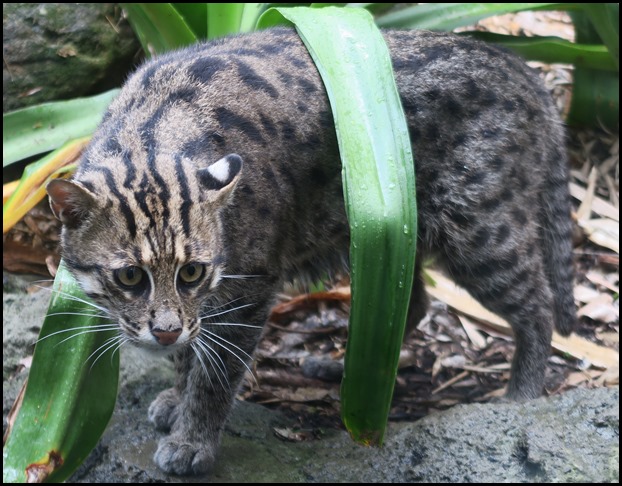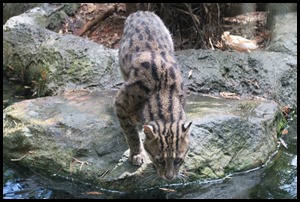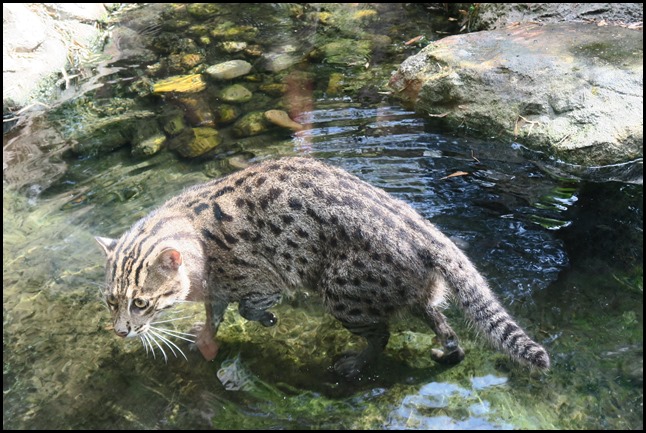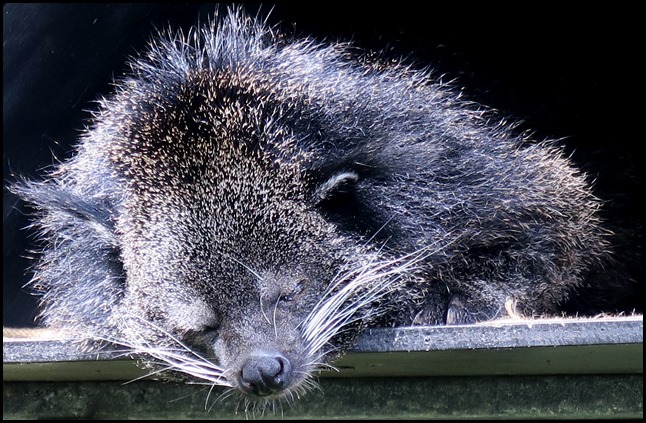Fishing Cat

|
The Fishing
Cat
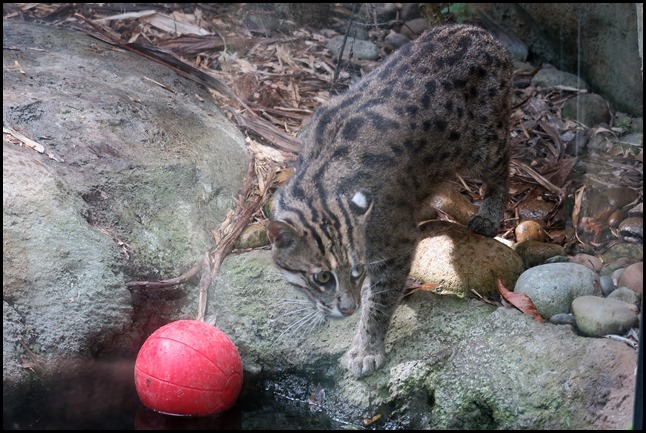 Whilst enjoying our zoo bimble, we
came across a first for both of us – the fishing
cat.
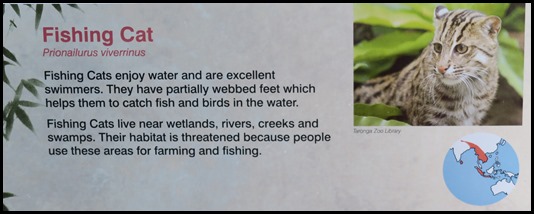 The
label.
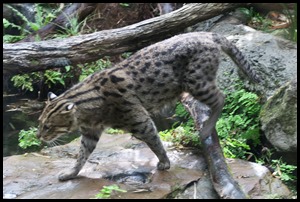 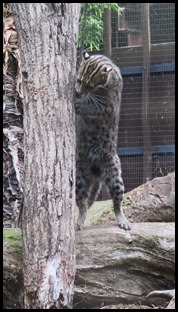 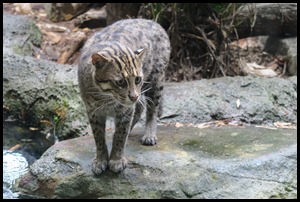 We watched this sleek feline hoping he
would go into the water.
The Endangered Cat website gave us some excellent
information:
HB Length: 57-115 cm (22-45″) Tail Length: 24-40 cm (9-16″) Height: 38-40 cm (15-16″) Weight: 5-16 kg (11-35 lbs) Pop. Trend: Decreasing
Larger than a domestic cat, the Fishing Cat Prionailurus viverrinus is well adapted to catching fish, its primary prey. They have a deep-chested body with short legs, a big, broad head, and a short tail. The short, coarse fur is a grizzled grey in colour, and tinged with brown. There are elongated dark brown spots arranged in longitudinal rows extending over the entire body. There are six to eight dark lines running from the forehead to the neck, and the underparts are whitish and spotted. The head is relatively big and broad, the muzzle somewhat elongated. Their eyes have greenish irises, and the ears are rather short and rounded, with black on the back and prominent white spots in the middle. The legs are short with the forelimbs having two distinct elbow bars. The tail is less than half the head and body length, is relatively thick, and has a series of incomplete rings with a black tip. Their front feet are partially webbed and their claw tips protrude from their sheaths even when retracted, leaving a signature track imprint. One remarkable feature is the layered structure of their fur, a crucial adaptation to life in the water. Next to the skin lies a layer of short hair so dense that water cannot penetrate it. Like snug-fitting thermal underwear, this coat helps keep the animal warm and dry even during chilly fishing expeditions. Sprouting up through the first coat is another layer of long guard hairs which gives the cat its pattern and glossy sheen.
Distribution: Fishing Cats have a discontinuous distribution in South East Asia, northern India and Sri Lanka. On the island of Java, it has become scarce and apparently restricted to a few coastal wetlands. Although they are thought to occur on Sumatra, there are no definite historic records, recent records have been shown to be erroneous, and its presence there remains to be confirmed. Fishing cats are widely distributed but concentrated primarily in wetland habitats, which are increasingly being settled, degraded and converted. These cats are typically found in a number of water habitats, including marshy thickets, mangrove swamps, and densely vegetated areas along rivers and streams. They have been recorded at elevations up to 1,525 metres in the Indian Himalayas where they frequent dense vegetation near rivers and streams. They have also been observed in degraded habitat such as near aquaculture ponds. A study on the island of Java found that Fishing Cats inhabit coastal wetlands less than 15 km from the ocean, no higher than 20 metres above sea level. Another radio telemetry study in a Nepal National Park found Fishing Cats were active only at night, and spent most of their time in dense grassland, sometimes away from water. Home ranges of three females were four to six square kilometres, and that of a single male was sixteen to twenty two square kilometres. Their presence in Cambodia was only confirmed in 2009, and their distribution in that country is poorly known. The identification of Fishing Cats there is difficult, due to their resemblance to the large geographical size variations of the Leopard Cat Prionailurus bengalensis. Juveniles of the two species are visually very similar.
Ecology: Fishing Cats are another feline that contradicts the belief that cats don’t like water. They are strong swimmers, and can cover long distances underwater. They have been seen wading and swimming in shallow water, hunting for a variety of aquatic prey. They often hunt for fish while fully immersed in water, and have been seen catching fish by plunging their heads under water, and flicking or scooping them out with their paws. One report describes them catching waterfowl by swimming underwater and seizing their legs from beneath. A one year study of scat analysis in India revealed that 76% of their food was fish, with some birds, insects and rodents also taken. Grass was present in the diet in all months except August, during the monsoon season. Fishing Cats are capable of taking large mammal prey, and have been seen scavenging livestock carcasses and Tiger Panthera tigris kills. They are thought to be primarily nocturnal but little is known of their behaviour in the wild. Reproduction: These cats are assumed to be polyestrous year round. They are said to have a characteristic mating call, but the call has not been described. Dens are constructed in dense shrubbery, reeds, hollow trees, in rocky crevices, or in other secluded locations. Kittens have been seen in the wild in April and June, and have been born at the Philadelphia Zoo in March and August. One to four, usually two, kittens are born after a 63 – 70 day gestation, and weigh around 170 grams at birth. Their eyes are open by 16 days, meat is taken around 53 days, and the kittens are weaned between four and six months. Adult size is attained at eight to nine months, and the young are independent between 12 – 18 months. It is thought that in the wild the adult male may help with the care and supervision of the young, but this is unverified. Captive individuals have lived to 12 years of age.
Conservation: Locally common in some areas of eastern India and Bangladesh, they have become increasingly difficult to locate throughout the remainder of their range. The scarcity of recent records suggests that over the past decade, they have undergone a serious and significant population decline. Even in protected wetlands and former Fishing Cat study areas, researchers have been unable to document their presence. On the island of Java, their prime mangrove habitat now covers less than 11% of the original area. Pollution by pesticide run-off from rice fields threatens these wetland predators who may accumulate toxins from their prey species. Fishing Cats on Java are also hunted and caught in fish traps. Poachers in Cambodia report the Fishing Cat is easily hunted for food, and protected areas contain evidence of widespread hunting where noose snares are commonly encountered. Wetland destruction is the primary threat facing this species, as over 50% of Asian wetlands are under threat and disappearing. Indiscriminate trapping, snaring and poisoning are also taking a toll. Fishing Cats are considered a food item in many areas of their range, and are also persecuted for taking domestic stock. A long-term study in Thailand found 9 of their 17 radio-collared cats had disappeared or been killed by poachers. Working with government officials, the researchers have had the Fishing Cat made part of the provincial natural resources protection policy, and an extensive public awareness conservation campaign is underway. Legends: At one time, missionaries and local people mistakenly reported this feline as a ‘kidnapper’, snatching infants from their cradles while they were sleeping.
We were thrilled when he did go in equally at home in the water.
A little while later we had another first, the Binturong. We read his label but saw nothing. It took quite a while to find this chap – soundo, so not really sure what he looks like standing up awake.
ALL IN ALL TWO COMPLETELY NEW ANIMALS FASCINATING AND MOST UNUSUAL |

